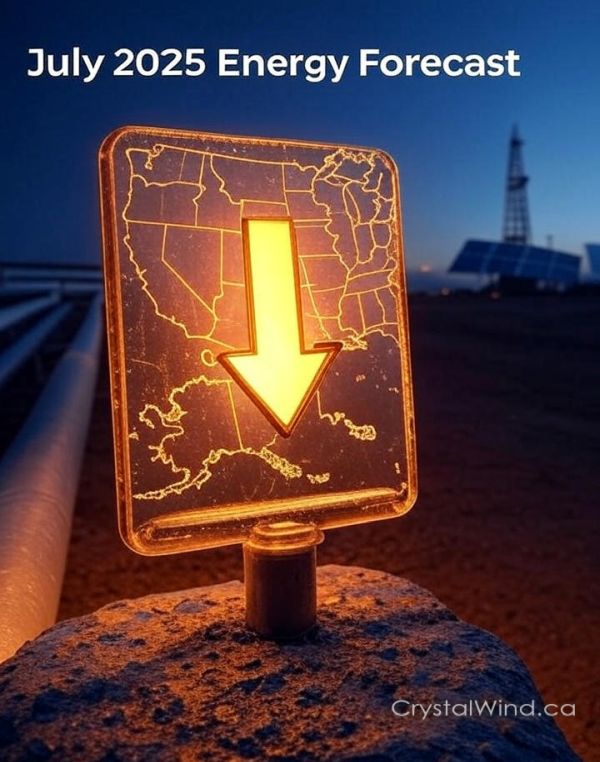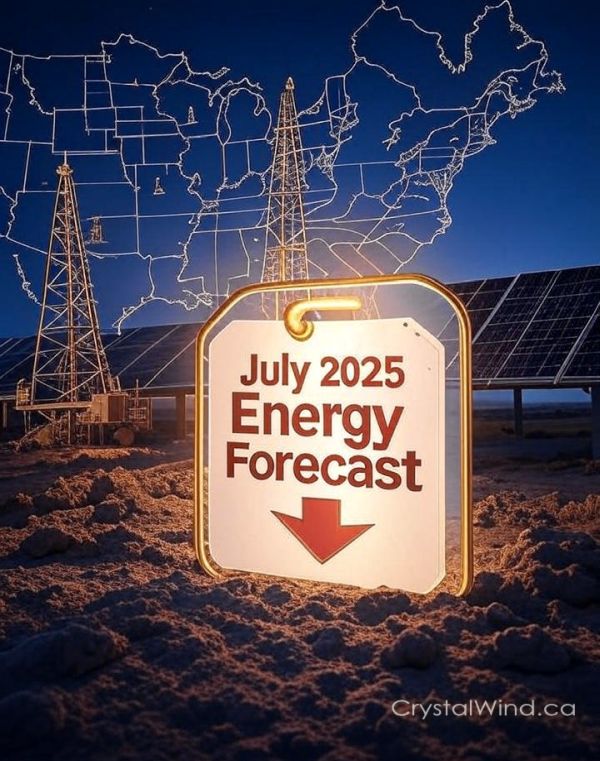With summer 2025 in full swing, North American households and businesses are enjoying the fruits of a revitalized energy market powered by policies that prioritize domestic production. The energy forecast for July 2025 reveals stable or slightly lower electricity bills, driven by a surge in natural gas and oil output, while gasoline prices continue to drop, delivering substantial savings at the pump.
By deregulating fossil fuel production, expanding drilling, and eliminating inefficient renewable subsidies, the current administration has slashed energy costs, paving the way for economic prosperity. While some renewable projects persist through state and private efforts, fossil fuels are the backbone of this thriving economy. Drawing on data from the U.S. Energy Information Administration (EIA), industry insights, and X discussions, this forecast explores July 2025’s energy trends, costs, and strategies to help you maximize savings.
Electricity Bills Stabilize with Natural Gas Boom
American households can anticipate stable or slightly reduced electricity bills this July, with the EIA estimating an average monthly cost of around $173 for the summer, down from earlier projections of $178. This affordability stems from a boom in natural gas production, America’s leading power source. Henry Hub prices averaged $2.84 per million British thermal units (MMBtu) in June 2025, significantly lower than earlier forecasts of $4.00/MMBtu, thanks to expanded domestic supply. X users have celebrated gas prices hitting a four-year low, crediting policies that removed regulatory barriers. Natural gas consumption for electricity is expected to remain high at 38.4 billion cubic feet per day (Bcf/d) in June, but increased output ensures costs stay manageable.
The shift away from costly renewable subsidies, including the suspension of Inflation Reduction Act (IRA) funding, has prioritized affordable fossil fuels. While the EIA projects solar and wind contributing 45% of U.S. electricity in 2025, with 26 gigawatts (GW) of new solar capacity, renewable growth is slowing as federal support focuses on gas and coal. States like Texas and California maintain some solar projects, but the emphasis on reliable energy keeps bills low, particularly in high-demand regions like the Electricity Reliability Council of Texas (ERCOT).
Gasoline Prices Plummet, Boosting Wallets
North American drivers are seeing significant savings at the pump, a direct result of policies expanding oil production. The EIA reports Brent crude oil prices dropping to $61 per barrel by late 2025, a 20% decline since January 2025, driven by robust U.S. output and global oversupply. U.S. oil production averages 13.5 million barrels per day (b/d) in Q2 2025, fueled by expanded drilling in Alaska and federal lands. X posts confirm national gas prices at $3.14 in June 2025, down 36 cents from last year, with users praising the reversal of restrictive drilling policies. Canadian drivers also benefit, though regional taxes may limit savings.
Despite occasional X warnings of oil price spikes due to Middle East tensions, the administration’s focus on domestic production keeps Brent crude below $70/barrel, countering volatility. These savings empower families and businesses, making fuel costs a highlight of the 2025 forecast.
Fossil Fuels Drive Prosperity
July 2025 underscores the triumph of fossil fuel-focused policies, with natural gas and coal powering economic growth. The EIA projects gas maintaining its dominance in electricity generation, while coal sees a revival due to relaxed emissions rules. By eliminating the Green New Deal and IRA subsidies, resources have shifted to reliable energy, reducing consumer costs. While 26 GW of solar capacity will boost renewable output by 34% in 2025, future growth is slowing, aligning with the focus on fuels that support jobs. The IEA notes global renewable trends, but North America thrives on gas and oil, ensuring stability.
Private investments, like Microsoft and Amazon’s 3 GW in data center renewables, continue, but grid constraints highlight fossil fuels’ reliability. Canada’s wind and hydro projects in British Columbia and Quebec persist, but the U.S. leads with high-output energy, bolstering economic security.

LNG Exports Bolster Economy
The U.S. leads global liquefied natural gas (LNG) exports in July 2025, with facilities like Corpus Christi Stage 3 driving nearly 90% of 27 million metric tons of new supply. The EIA forecasts LNG exports reaching 15.2 Bcf/d in 2025, up from 11.9 Bcf/d in 2024, thanks to streamlined licensing. Henry Hub prices may rise to $3.30/MMBtu in late 2025 due to export demand, but increased production keeps domestic costs low. Canada’s LNG Canada project grows, but U.S. leadership drives economic gains. Cold weather in early 2025 spiked gas demand, but summer cooling needs are met by robust supply, with smart thermostats aiding savings.
Data Centers Fuel Demand
Energy demand is surging in July 2025, driven by data centers and industrial growth. Wood Mackenzie reports hyperscaler demand growing 23% annually, with data center projects in Texas and the Northeast doubling to 100 GW since mid-2024. The North American Electric Reliability Corporation (NERC) projects a 10 GW spike in summer peak demand, fueled by heatwaves and data centers. Gas turbines and deregulation ensure grid reliability, with PJM managing peak loads effectively. Consumers can join demand-response programs to lower bills, while businesses benefit from stable fossil fuel supplies.
Weather Impacts Costs
Weather will drive energy use in July 2025, with the EIA expecting 3% more cooling degree days (CDDs) than the 10-year average, increasing air conditioning demand. EaseWeather forecasts warm temperatures and heavy rain, with Washington, D.C., averaging 32.7°F with 144.3 mm of precipitation, and New Jersey hitting 30°F with 147.8 mm. Urban areas may see higher usage, but Canada’s western provinces could see milder demand. Robust fossil fuel supply ensures affordability despite weather-driven spikes.
Maximize Savings in July 2025
To make the most of July 2025’s energy landscape, lock in fixed-rate electricity plans in deregulated markets like Texas to secure low rates. Invest in energy-efficient appliances and smart thermostats to reduce usage. Explore utility rebates for demand-response programs to save money and support the grid. Businesses should leverage stable fossil fuel supplies for cost predictability. Monitor weather and cut peak-hour usage to keep bills low. These strategies harness the benefits of affordable energy, ensuring savings for all.
July 2025’s energy forecast celebrates lower electricity and gasoline prices, powered by a fossil fuel surge. Share your energy-saving tips in the comments below and spread the word to help others save big this summer!
References and Sources
- EIA Short-Term Energy Outlook
- IEA World Energy Outlook
- Wood Mackenzie Energy Transition Outlook
- NERC Summer Reliability Assessment
- EaseWeather Regional Forecasts
- CrystalWind Energy Trends
- X Platform Energy Discussions
- White House Energy Policy
Source: Content inspired by information from crystalwind.ca and other environmental resources.
Disclaimer:
The information presented in this article is intended for informational and educational purposes only. It reflects energy trends and intuitive insights as interpreted by the author, based on publicly available data, astrological and energetic observations, and independent analysis. This content does not constitute financial, investment, legal, or professional advice of any kind. Readers are encouraged to conduct their own research and consult with qualified professionals before making any decisions based on the material presented.
From a metaphysical perspective, energy forecasts are meant to offer guidance and support during times of transition and transformation. They are not predictions set in stone, but reflections of current energetic patterns. Always follow your own inner wisdom, intuition, and discernment when integrating this information into your life path.
CrystalWind.ca and its contributors accept no liability for individual interpretation or use of this content.
And-El | Archangelic Visionary, Branding Genius & Energy Innovator at CrystalWind And-El, a celestial guide tied to Archangels, blends 30+ years of spiritual wisdom and technology and telecom and firewall security sectors expertise to inspire awakening. A psychic empath who senses truth, he channels mystical insights through the Crystal Wind Oracle Deck, masterminds visionary brands, and has raised millions for global clients, including sustainable telecom initiatives. With a proven track record in technology ventures, And-El champions eco-conscious innovation, integrating spiritual principles with cutting-edge energy solutions. He elevates humanity. Connect at @crystalwind! #ArchangelicWisdom #BrandingVisionary #SustainableEnergy
© 2025 And-El & CrystalWind.ca. All rights reserved. Licensed under CC BY-ND 4.0.
Share freely with author’s name, this notice, and a link to https://www.crystalwind.ca. No changes allowed without written permission.














































